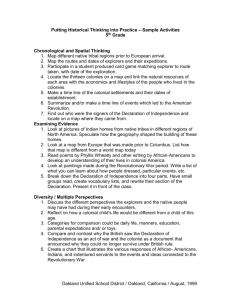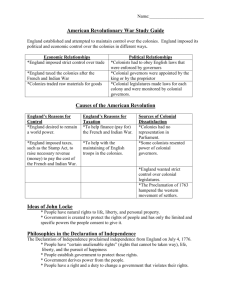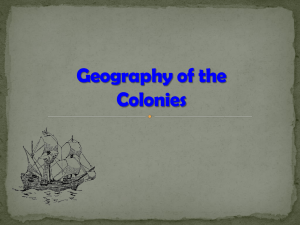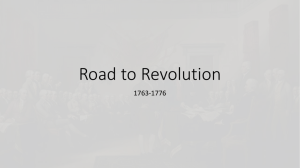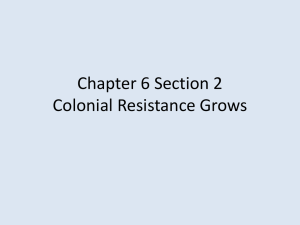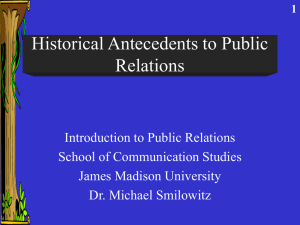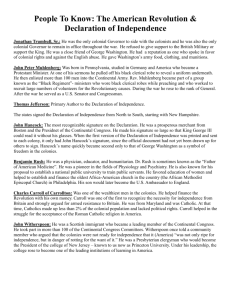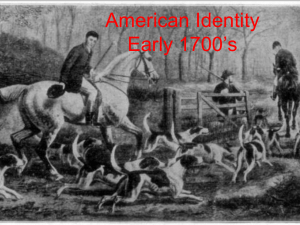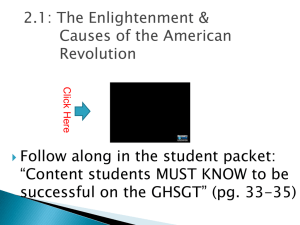2-1 Colonial Resistance and Rebellion
advertisement
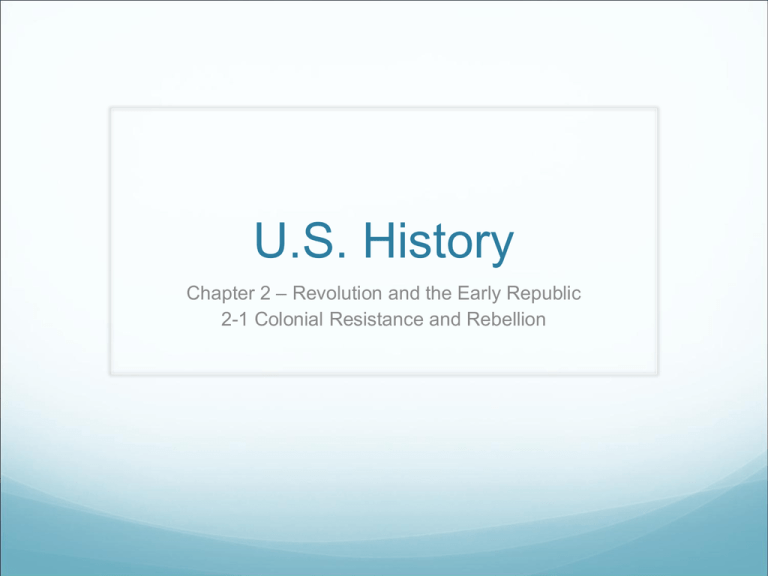
U.S. History Chapter 2 – Revolution and the Early Republic 2-1 Colonial Resistance and Rebellion Declaration of Independence 3 minutes http://www.youtube.com/watch?v=jYyttEu_NLU Colonial Resistance and Rebellion CA Standards: 11.1.1 Describe the Enlightenment and the rise of democratic ideas as the context in which the nation was founded. 11.1.2 Analyze the ideological origins of the American Revolution Objectives: • Summarize colonial resistance to British taxation • Trace the mounting tension in Massachusetts • Examine efforts made to avoid war between the colonies and the British • Summarize the historical background of the Declaration of Independence Homework Write definition of terms & names found on page 17 in workbook and page 58 of textbook • • • • • • • • • • Loyalists Patriots Saratoga Valley Forge Inflation Marquis de Lafayette Charles Cornwallis Yorktown Treaty of Paris Egalitarianism Read pages 58-65 The Americans: Reconstruction to the 21st Century Prepare for Open notebook Quiz Colonial Resistance & Rebellion Main Idea Conflicts between Great Britain and the American colonies escalated, until the colonists finally declared their independence Colonial Resistance & Rebellion Why It Matters Now The ideas put forth by the colonists in the Declaration of Independence remain the guiding principles of the United States today. Colonial Resistance & Rebellion Terms & Names page 46 King George III John Locke Sugar Act Common Sense Stamp Act Thomas Jefferson Samuel Adams Boston Massacre Boston Tea Party Declaration of Independence Notes: 2-1Guided Reading Colonial Resistance & Rebellion Read Pages 15 & 16 Reading Study Guide Notes: 2-1Guided Reading 1. How did the colonists respond to new taxes? Colonial assemblies protested; Merchants and Samuel Adams organized boycotts of British goods. Notes: 2-1Guided Reading 2. How did Britain try to punish Boston for its protests? The British declared martial law in Boston to punish the city for its protests Notes: 2-1Guided Reading 3. What actions did the colonies take to prepare for war? Some New Englanders became minutemen & stored weapons. The 2nd Continental Congress formed the Continental Army and named George Washington to be the General. Notes: 2-1Guided Reading 4. What ideas of John Locke did Thomas Jefferson put in the Declaration of Independence? Jefferson used Locke’s idea that people have the right to life and liberty. John Locke John Locke - English philosopher People have natural rights to life, liberty, and property. Every society is based on a social contract – an agreement in which the people consent to choose & obey a government so long as it safeguards their natural rights. If the government violates that social contract by taking away those rights – the people have the right to resist and even overthrow the government Common Sense Thomas Paine wrote the pamphlet Common Sense Very popular among the colonists. Paine stated that independence would allow America to trade more freely. It would give colonists the chance to create a better society – free from tyranny. A society with equal social and economic opportunities for all. Pamphlet convinced many colonists to want independence. Declaration of Independence 14 minutes http://www.youtube.com/watch?v=jYyttEu_NLU Be prepared for open notebook quiz
